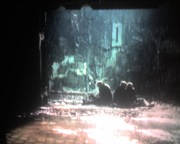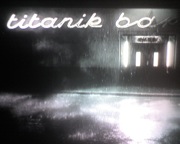There are few elements that, used in film, produce both sound and image at the same time. Fire–and in its form as an action event, the explosion– and water are the two that come to mind. Light and darkness are soundless, and most sonic elements don’t have a visual correlate of much use to the film-maker. Rain, raining, running, in rivers and sheets, or in hushed continuity… rain is among the film-maker’s most pliant, flexible, and rewarding materials.
Not only does rain vary in tone, it falls with lesser or greater urgency. In films it can fall without wetness, as a sheet wrapping the scene in textured translucency, enhancing the image when it registers well, even though it obcures it at the same time. Indeed rain can make a scene more difficult to see, but create interest in the scene in the process. Rain might blow and create motion, running like a mad spirit first to left and then reversing and blowing suddenly to the right, across faces it has caught in its flushing wake.
When used by some, rain rains, it truly pours down, thus giving us the skies above, though we may not see them. Rain falls, in drops descending as they are bound by the earth to do, and rarely do we see an upward gushing, for rainfall falls for a reason, and that reason is the reason the film-maker welcomes the rain.
Rain is melancholic but not sad, it is usually cold, wet, and uncomfortable, but in film it has no temperature and becomes moving image, an element as pure as any made for film. Rivers flow, but we cannot film flowing rivers and be in them as we are in a scene shot in the rain.

Rain is time, rain is the reign of time, in rain it is time that rains. But as times are different in film, so too are rains. Tarkovsky’s rain is a rain-event, rain falling, in light and shadow, rain as sculpture, as a column of rain falling through a hole in the ceiling of a room. Rain in Tarr is a sentimental field, a wash of mood, used to wipe the lens and the eye and to perpetuate a sentiment even and in spite of action developing within it. Rain in Tarkovsky is isolated, contained, unless it is really raining outside. Rain in Tarr reaches from edge to soaked edge, containing but not contained, as unbroken a field as light itself, a visual plane or surface, where Tarkovsky’s rains are perhaps more like thin waterfalls and magical moments.
Rain is sublime, it arouses thought, and yet in many ways it suggests nothing, nothing it all.
